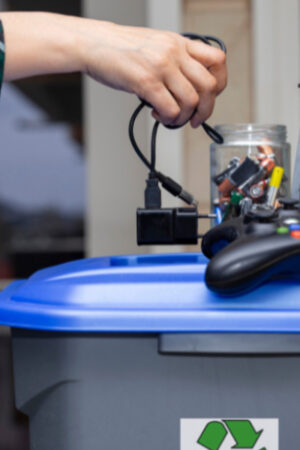As digital devices become increasingly essential daily, the amount of electronic waste (e-waste) generated has risen dramatically. In Singapore, managing this waste has become a pressing concern due to its potential environmental and health hazards. Understanding the e-waste disposal process is crucial for responsible management. Here’s a complete guide on how e-waste disposal works in Singapore, from collection to recycling.
1. Understanding E-Waste and its Importance in Singapore
E-waste refers to discarded electrical or electronic devices that are no longer used. In Singapore, e-waste management is a critical issue, as the rapid pace of technological advancements means old devices are being replaced at an accelerated rate. Proper disposal is necessary to prevent harmful substances such as lead and mercury from contaminating the environment. E-waste disposal in Singapore is tightly regulated to ensure these materials are handled safely and responsibly.
2. How to Dispose of E-Waste in Singapore
The first step in e-waste disposal is knowing where to drop off unwanted electronic devices. Many residents and businesses must be aware of Singapore’s designated e-waste disposal points. Fortunately, the country has established numerous collection points in convenient locations, such as public libraries, shopping malls, and dedicated drop-off bins. These collection points allow for the safe collection of e-waste, preventing it from ending up in landfills.
3. E-Waste Collection: Convenience and Accessibility
Several recycling programmes are available for individuals and businesses looking for convenience. The National Environment Agency (NEA) has partnered with authorised e-waste recycling companies to manage collection and disposal. In addition to public collection points, these companies may offer door-to-door collection services, making it easy for households and offices to recycle electronic devices. Local organisations are also promoting community-based initiatives, raising awareness about the importance of proper e-waste disposal.
4. Sorting E-Waste for Recycling
Once e-waste is collected, it must be sorted before recycling can occur. Sorting involves separating different types of electronic waste based on their material composition. This process is essential as it ensures that hazardous substances like batteries and plastics are safely extracted before recycling begins. Electronics such as computers, printers, and televisions are often sorted into categories such as metals, plastics, and circuit boards. This step helps streamline the recycling process and maximises the recovery of valuable materials.
5. E-Waste Recycling in Singapore: Process and Benefits
E-waste recycling in Singapore involves breaking down electronic devices into reusable materials. After sorting, the components are sent to specialised recycling facilities, where they undergo a series of processes, such as shredding and heating. During these stages, valuable materials like copper, aluminium, and precious metals like gold and silver are recovered. These materials can be reused to produce new devices, reducing the need for raw materials. Additionally, responsible e-waste recycling helps prevent the release of harmful substances into the environment.
6. The Role of E-Waste Recycling Companies
E-waste recycling companies play a pivotal role in ensuring the recycling process runs smoothly. They are responsible for handling the collection, sorting, and processing of e-waste in compliance with Singapore’s strict environmental regulations. By adhering to these guidelines, recycling companies help reduce the environmental impact of e-waste. Many companies also offer secure data destruction services, ensuring personal information is safely erased from devices before disposal.
7. Legislative Measures for E-Waste Disposal
In Singapore, e-waste management is guided by the Extended Producer Responsibility (EPR) framework, which holds manufacturers accountable for the end-of-life disposal of their products. Under this framework, electronics producers are required to ensure their products can be recycled at the end of their lifespan. This approach encourages manufacturers to design more sustainable products. It improves the overall efficiency of e-waste disposal systems in Singapore.
8. E-waste disposal at the Household Level
Disposing of electronic waste responsibly is straightforward for households. Residents can use the convenient collection points or opt for the e-waste recycling services offered by various companies. It is important to note that items such as old mobile phones, printers, and laptops should not be thrown into regular bins but instead taken to dedicated e-waste disposal locations. Singapore residents are encouraged to check for local recycling events that allow for the safe disposal of household electronics.
9. E-waste Management for Businesses
Businesses are equally responsible for managing their e-waste. Companies must ensure that their old devices, from office computers to telecommunications equipment, are correctly recycled. Many businesses work with certified e-waste disposal companies to handle their e-waste, ensuring compliance with environmental standards. A clear e-waste disposal policy within the company helps promote sustainability and environmental stewardship.
10. The Future of E-Waste Disposal in Singapore
As technology evolves, the demand for effective e-waste disposal will only increase. The Singaporean government continuously develops innovative solutions to improve the e-waste management system. This includes exploring advanced recycling techniques and encouraging local participation in e-waste disposal programmes. Through these efforts, Singapore aims to set an example for other countries on effectively managing electronic waste while promoting a circular economy.
Conclusion: Why Proper E-Waste Disposal Matters
E-waste disposal in Singapore is an essential part of maintaining environmental sustainability. Through proper collection, sorting, and recycling, Singapore can reduce the harmful effects of e-waste on the environment and public health. By following the correct disposal procedures, residents and businesses can contribute to a cleaner, greener Singapore.
For more information, contact Metalo International today.




